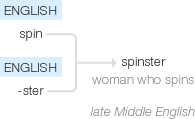Spinster
late Middle English (in the sense ‘woman who spins’): from the verb spin + -ster; in early use the term was appended to names of women to denote their occupation. The current sense dates from the early 18th century.
wiktionary
From Middle English spynnester(“woman who spins fibre”), from c. 1350; equivalent to spin + -ster. The semantic development is from a historical notion of unmarried women spinning thread for a living.
etymonline
spinster (n.)
mid-14c., "female spinner of thread," from Middle English spinnen "spin fibers into thread" (see spin (v.)) + -stere, feminine suffix (see -ster). Unmarried women were supposed to occupy themselves with spinning, hence the word came to be "the legal designation in England of all unmarried women from a viscount's daughter downward" [Century Dictionary] in documents from 1600s to early 1900s, and by 1719 the word was being used generically for "woman still unmarried and beyond the usual age for it."
Spinster, a terme, or an addition in our Common Law, onely added in Obligations, Euidences, and Writings, vnto maids vnmarried. [John Minsheu, "Ductor in Linguas," 1617]
Strictly in reference to those who spin, spinster also was used of both sexes (compare webster, Baxter, brewster) and so a double-feminine form emerged, spinstress "a female spinner" (1640s), which by 1716 also was being used for "a maiden lady." Related: Spinsterhood.
